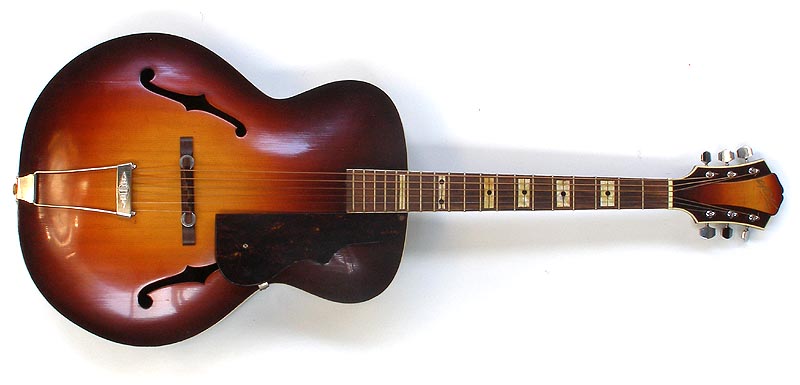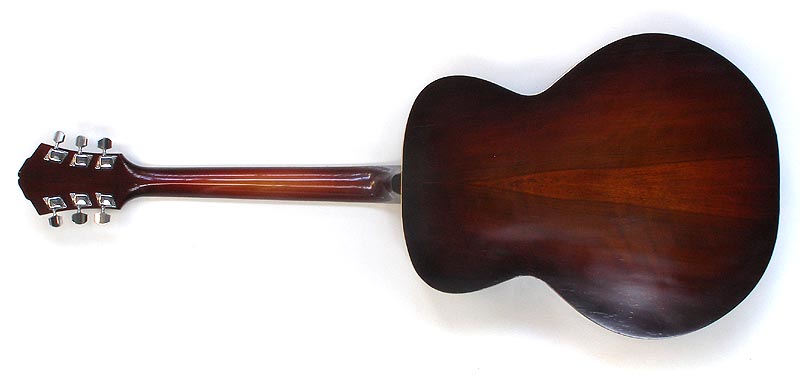

| This vintage Maton archtop acoustic guitar has had only two owners, the first having owned it for some 57 years, before it was left to the second owner as an inheritance. Serial number (on the original type of Maton label - these are very rare!) is 144, and the back of the headstock has the inked stamp just legible which says Made in Australia Reg Des No 23070. According to Maton records, serial numbers on this model ranged from 101 to 458, and Maton has verified that this instrument, the 44th Goldtone made, was made in 1947. 358 Goldtones were made before the model was phased out in 1959. The character of the solid carved top displays distinct German influences, with the quite distinct flat perimeter before the commencement of the arch, much like early Hopf, and other archtops. Later, Maton archtops would become more American in nature, with a more gradual and shallower arch which commenced almost immediately from the rim, without the distinct perimeter. Even the fretboard inlays, which are of a type I've never seen on any other Maton, are much more German than American in character. Later examples of the model reverted to simple dots or blocks, rather than the quite unique inlays on this early example. The body woods are interesting. Top is carved solid Spruce, and the body sides and neck appear to be Maple. However, the back, which is definitely original, is made from a different, much darker timber with a beautiful figuring. When I brought the guitar to Maton, Managing Director Neville Kitchen said he thought it may well be Walnut, as Bill May had made several guitars with a Walnut back at the time. The mix sounds wonderful, with a lot more bottom end to the sound compared to straight Spruce/Maple bodied archtops, while losing none of their projection and cutting power. While the guitar is in amazing condition (both Neville Kitchen and Merv Cargill seemed to think the finish is original), it has suffered the usual afflictions of a vintage archtop, with some loss of neckset. The action is still very good as-is, and the guitar sounds extremely nice, but I intend to book the guitar in with Jim Cargill in Melbourne when his workload eases a little to have a full neck reset done, which will restore the original neck angle, bridge height and string break angle over the bridge, increasing volume and tone. The price at that point will rise accordingly, to a little over the $3000AUD mark. Your choice at this point is to purchase a beautiful and playable guitar as-is for the present price, or to buy the guitar at the new price after the correction work has been undertaken. One mystery which has all parties stumped is the plugged output jack hole in the lower bass bout. The plug (see the detailed photo in the 'more pictures' link below) is clearly underneath the finish, and experts seem to agree that the finish is original. Was this guitar originally destined to be an electric version, but then finally produced as an acoustic? Even looking a the plug both inside and outside the body, it seems to have only been possible to have done the work while the back or top of the guitar was removed, yet there is no sign whatsoever that the top or back have ever been removed, further pointing a factory fitting of the plug. I guess the mystery will never be solved completely! Tuners are non-original, and appear to have been changed many decades ago, probably back in the 1960s. There is also evidence that a strap lug was once present on the neck heel - the lug has long since been removed and the screw hole professionally filled. The finish exhibits some age checking, particularly in the darker-tinted areas, such as the neck heel and the back of the headstock (see the detail pics). There is also an old but stable crack in the top emanating from the upper F-hole to the lower edge of the guitar, but when I pointed it out to Merv Cargill he considered it to be a non-issue. The original case is still present, but has deteriorated appreciably (cardboard only has a finite life, and 60 years is pushing it!), and is effectively useless. I have purchased a brand new plush-lined hard shell acoustic guitar case for this vintage Maton archtop. Sold to Steve |